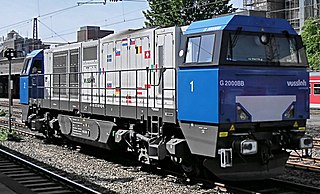Vossloh AG is a rail technology company based in Werdohl in the state of North Rhine-Westphalia, Germany. The SDAX-listed group has achieved sales of around €930 million in 2016 with more than 4,000 employees.
Maschinenbau Kiel GmbH designed, manufactured and marketed marine diesel engines, diesel locomotives and tracked vehicles under the MaK brand name. The three primary operating divisions of Maschinenbau Kiel GmbH were sold to different companies in the 1990s.

NSB Di 6, later designated ME 26 and DE 2700, is a class of twelve diesel-electric locomotives built by Siemens for the Norwegian State Railways (NSB). The prime mover provides a power output of 2,650 kilowatts (3,550 hp), a starting traction effort of 400 kilonewtons (90,000 lbf) and a maximum speed of 160 kilometres per hour (99 mph). They have a Co′Co′ wheel arrangement. The bidirectional locomotives were designed for use with both passenger and freight trains.
Turbo transmissions are hydrodynamic, multi-stage drive assemblies designed for rail vehicles using internal combustion engines. The first turbo-transmission was developed in 1932 by Voith in Heidenheim, Germany. Since then, improvements to turbo-transmissions have paralleled similar advances in diesel motors and today this combination plays a leading role worldwide, second only to the use of electrical drives.

The NMBS/SNCB Class 77 is a class of 4 axle B'B' road switcher diesel hydraulic locomotive designed for shunting and freight work manufactured at the beginning of the 2000s by Siemens Schienenfahrzeugtechnik and later by Vossloh at the Maschinenbau Kiel plant in Kiel, Germany for the National Railway Company of Belgium (SNCB/NMBS).

The Voith Gravita locomotives are a family of road switcher diesel-hydraulic locomotives built by Voith Turbo Lokomotivtechnik GmbH & Co. KG. Available in a range of configurations from 4 to 6 axles, they are designed for shunting and light and medium freight operations.

The Stadler Euro is a class of diesel-electric locomotives built by Stadler Rail for the European market. It is available in two basic variants, the four-axle Euro 3000, and the six-axle Euro 4000. These locomotives are powered by EMD 710 prime movers. A six-axle electric-only variant is marketed as Euro 6000; it is also built for the Iberian gauge.

The G 2000 BB is a four axle heavy shunting and mainline locomotive, designed by German company Vossloh and built at the former MaK plant in Kiel. At the time of its introduction in 2000 it was the most powerful hydraulic transmission locomotive in Vossloh's range.

The Vossloh G1206 is a B'B' diesel hydraulic freight locomotive built in Kiel and used by several European railway operators including a SNCF specific variant the BB 461000 series.

The DB Class 240 are a class of Co′Co′ diesel-electric locomotives which were produced in the 1980s by MaK in collaboration with Krupp and ABB as DE 1024 as prototypes/technology demonstrators for a possible future order from the Deutsche Bundesbahn.

The DR 130 family of locomotives comprises the DR Class 130, DR Class 131, DR Class 132 and DR Class 142, in USSR locomotive called TE109 and TE129.

The Vossloh G1700 BB is a four axle B′B′ medium power diesel-hydraulic locomotive manufactured by Vossloh Locomotives GmbH. in Kiel.

The ÖBB 2070 is a class of 90 shunting and light multipurpose four axle B'B' Diesel-hydraulic locomotive built for the Austrian Federal Railways by Vossloh at the MaK locomotive plant in Kiel, Germany.

The Vossloh G1000 BB is a class of off-centre cab diesel-hydraulic B'B' 4 axle locomotives built by Vossloh in Kiel since 2002. When operating under Swiss ownership the locomotives have received the class Am 842, several units owned by the Société Nationale des Chemins de Fer Luxembourgeois are classified as CFL class 1100.

The Vossloh G6 is a C diesel-hydraulic shunting locomotive, and the first locomotive of Vossloh's fifth generation programme. The G6 is the successor of the MaK/Vossloh G765, a third-generation MaK locomotive still offered in the 2000s.

The VSFT G322 is a B diesel-hydraulic shunting locomotive, initially built for and in service with the Danish Railways DSB as Class MK.

The Stadler Eurolight is the brand name for a family of 4-axle Bo'Bo' mainline diesel-electric locomotives with sub-20-tonne axleloads for passenger and freight trains produced by Stadler Rail.

The Vossloh DE 18 is a Bo′Bo′ diesel-electric locomotive. It is the first new diesel-electric locomotive to be built in Kiel since production of the DE 1002 ended in 1993. Up to 60% of the components are shared with the diesel-hydraulic G 18.

SNCF BB 69000 were a pair of two prototype high-power diesel-hydraulic locomotives, numbered BB 69001 and BB 69002. They were built at the same time, and for comparison with, as a diesel-electric version, CC 70000. The use of hydraulic transmission saved 30 tons in weight and enabled the locomotives to run on four axles instead of the six axles of the diesel-electric.

The second use of the TOPS classification Class 21 for locomotives used on the British railway network came through the use of a number of related diesel-hydraulic and diesel-electric locomotives procured following the opening of the Channel Tunnel. The total of 16 locomotives were obtained by two separate operators, with some used for freight, and others to propel service trains and as "Thunderbird" locomotives.

















